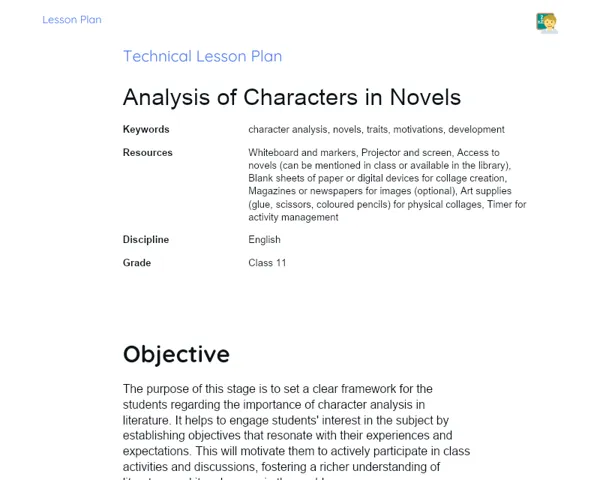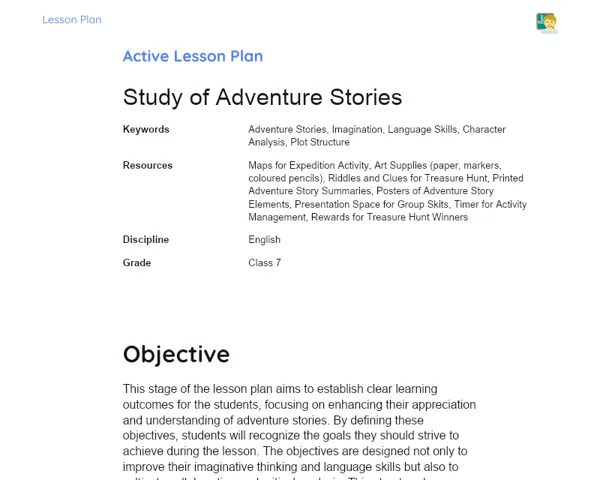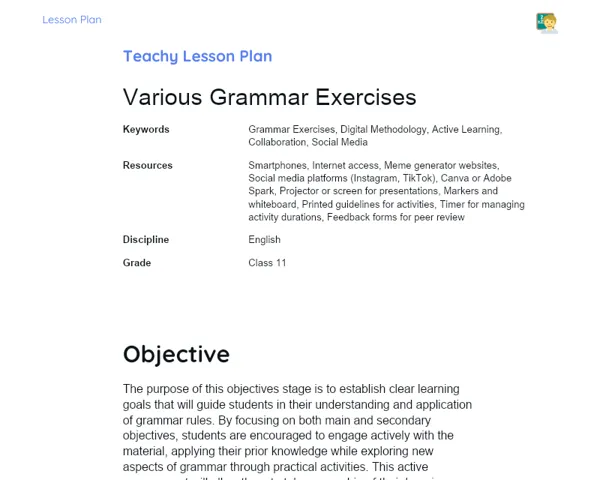Lesson Plan | Lesson Plan Tradisional | Verbs: Can
| Keywords | Verb 'can', Permission, Ability, Affirmative sentences, Negative sentences, Questions, Short responses, Practical examples, Communication in English, Everyday situations |
| Resources | Whiteboard, Markers, Projector (optional), Presentation slides, Sheets of paper, Pens, Printed support material featuring examples of how to use 'can', Exercise list for practice |
Objectives
Duration: (10 - 15 minutes)
The aim of this stage is to ensure students appreciate the significance and diverse applications of the verb 'can' in English. Through comprehensive explanations and relatable examples, students will be better equipped to recognize and confidently use 'can' to convey both permission and ability in varied communication settings.
Objectives Utama:
1. Discuss in detail the various uses of the verb 'can' in English, emphasizing contexts like permission and ability.
2. Provide clear, relatable examples showcasing the use of 'can' in affirmative, negative, and interrogative sentences.
3. Help students understand how to practically use 'can' in everyday scenarios and address any doubts that arise.
Introduction
Duration: (10 - 15 minutes)
The objective of this stage is to pique students' interest and establish a clear and relatable context for using the verb 'can'. By linking the topic to everyday situations and intriguing facts, students will feel more enthusiastic about learning and grasp the practical importance of the material being covered.
Did you know?
Did you know that 'can' is one of the most frequently used modal verbs in English? It remains unchanged, no matter who is executing the action. This means, unlike many other verbs, we don't need to fret about conjugation with 'can'. For instance, 'I can', 'you can', 'he can' — they all share the same form. This makes using 'can' straightforward and user-friendly!
Contextualization
Kick off the lesson by explaining to students that the verb 'can' is a dynamic and flexible word in English. It’s utilized to communicate abilities, capacities, and permissions. Just like in Hindi when we say 'kar sakta hoon' or 'kar sakti hoon', in English we express similar ideas using 'can'. For instance, 'I can swim' translates to 'Main tair sakta hoon'. Highlighting that mastering 'can' will enable them to articulate their thoughts with greater clarity and confidence in their daily interactions.
Concepts
Duration: (45 - 50 minutes)
This stage aims to solidify students' understanding of the verb 'can' through a thorough explanation of its affirmative, negative, and interrogative forms. By offering relatable examples and encouraging active participation, the teacher ensures that students can accurately apply the use of 'can' in a variety of scenarios. Class discussions around the posed questions reinforce the content and allow for assessment of comprehension.
Relevant Topics
1. Affirmative sentences with 'can': Clarify that in positive sentences, 'can' expresses abilities or capacities. For example, 'I can swim' (Main tair sakta hoon). Emphasize that the structure is straightforward: Subject + 'can' + main verb.
2. Negative sentences with 'can': Explain that forming negative sentences requires adding 'not' after 'can', leading to 'cannot' or the shorter form 'can't'. For example, 'I can't swim' (Main nahi tair sakta hoon). The structure is: Subject + 'can't' + main verb.
3. Interrogative sentences with 'can': Stress that in questions, 'can' comes at the start of the sentence. For instance, 'Can you swim?' (Kya aap tair sakte hain?). The structure is: 'Can' + Subject + main verb?
4. Use of 'can' to ask for permission: Explain that 'can' is also used for requesting or granting permission. For example, 'Can I go to the bathroom?' (Kya main bathroom ja sakta hoon?).
5. Short responses: Teach students that short responses can use 'can' and 'can't' alone. For example, 'Can you swim?' 'Yes, I can.' or 'No, I can't.'
To Reinforce Learning
1. Create an affirmative sentence using 'can' to describe a talent of yours.
2. Turn the sentence 'She can play the piano' into a question.
3. Form a negative sentence using 'can' to express something you cannot do.
Feedback
Duration: (20 - 25 minutes)
This stage seeks to review and reinforce students' comprehension of the verb 'can' through an in-depth discussion of answers to the given questions. By prompting student engagement and reflections, the teacher can assess content comprehension, correct possible misunderstandings, and clear up any confusion, ensuring students develop a strong and applicable understanding of the material taught.
Diskusi Concepts
1. Create an affirmative sentence using 'can' to describe a talent of yours. 2. Explain that students should utilize the structure Subject + 'can' + main verb. For example, 'I can draw' (Main chitra bana sakta hoon). 3. Transform the sentence 'She can play the piano' into a question. 4. Clarify that to change an affirmative sentence into a question, 'can' must be repositioned at the start. The structure is: 'Can' + Subject + main verb? The new sentence will be 'Can she play the piano?' (Kya woh piano baja sakti hai?). 5. Write a negative sentence using 'can' to denote something you cannot do. 6. Clarify that to form a negative sentence, you should add 'not' after 'can', creating 'cannot' or its shorter form 'can't'. The structure is: Subject + 'can't' + main verb. For instance, 'I can't sing' (Main nahi ga sakta hoon).
Engaging Students
1. Encourage students to share their affirmative, negative, and interrogative sentences formed with 'can'. 2. Ask them about everyday scenarios where they might use 'can' to seek permission or express abilities. 3. Motivate students to brainstorm additional sentences they could form using 'can' in various contexts. 4. Have a discussion on how grasping the proper use of 'can' can enhance their communication skills in English.
Conclusion
Duration: (10 - 15 minutes)
The aim of this final stage of the lesson plan is to review and solidify the key takeaways, ensuring students grasp a clear and comprehensive understanding of how to use the verb 'can'. By summarizing the content, linking theory to practice, and underscoring the importance of the topic, the teacher reinforces student learning and prepares them to apply their newfound knowledge independently.
Summary
["The verb 'can' helps us express abilities, capacities, and permissions.", "In affirmative sentences, the structure is: Subject + 'can' + main verb.", "To create negative sentences, use 'cannot' or its short form 'can't' after the subject.", "In questions, 'can' begins the sentence.", "'Can' is also used for asking or giving permission.", "Short answers can be formed using just 'can' or 'can't.'"]
Connection
The lesson intertwined theory with practice by supplying clear and relatable examples of how to use the verb 'can' in various contexts. Through practical tasks and class discussions, students could apply theoretical concepts to real-life situations and appreciate the importance of accurately using this verb in English communication.
Theme Relevance
The verb 'can' is crucial for daily conversations in English, allowing students to express their skills, capacities, and seek permissions clearly and effectively. Understanding this verb eases communication across different contexts, from casual chats to comprehending guidelines and instructions, becoming an invaluable tool for mastering English.



